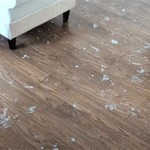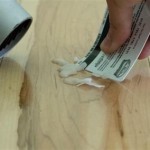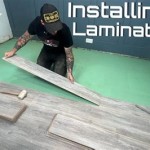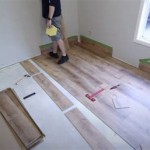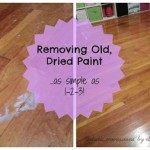How To Remove Carpet Glue From Wood Flooring
Removing carpet glue from wood flooring is a task that demands patience and careful execution. The adhesive used to secure carpets can leave a stubborn residue that is difficult to eradicate without damaging the underlying wood. A systematic approach, combined with the right tools and techniques, is essential for achieving a clean and restored wood surface. This article will provide a comprehensive guide to safely and effectively removing carpet glue from wood flooring.
Before commencing the removal process, it's crucial to identify the type of wood flooring present and the type of adhesive used. Different types of wood, such as hardwood (oak, maple, cherry) and softwood (pine, fir), respond differently to cleaning agents and scraping tools. Similarly, varying types of carpet glue, including solvent-based, water-based, and pressure-sensitive adhesives, require different removal strategies. Identifying these factors will help in selecting the appropriate methods and minimizing the risk of causing damage to the wood.
Safety precautions are paramount throughout the entire removal process. When working with solvents or chemical removers, adequate ventilation is essential. Open windows and doors to ensure a constant flow of fresh air. Wear appropriate personal protective equipment (PPE), including gloves, safety glasses, and a respirator, to prevent skin irritation and respiratory problems. Avoid direct contact with the adhesive and any cleaning agents. Always read and follow the manufacturer's instructions for all chemicals used.
Preparation and Assessment
The initial step involves a thorough assessment of the area affected by the carpet glue. Remove any remaining carpet fibers or padding that may be adhering to the glue. Use a utility knife or scraper to carefully lift and remove these larger pieces. Vacuum the area to remove loose debris, dust, and dirt. This provides a clearer view of the glue residue and facilitates the subsequent removal process.
Next, perform a test patch in an inconspicuous area of the flooring to determine the wood's reaction to the chosen removal method. Apply a small amount of the selected solvent or heat to the test area and observe for any signs of discoloration, softening, or damage to the wood finish. This precautionary measure helps to prevent widespread damage should the chosen method prove unsuitable. Allow the test patch to dry completely before proceeding with the main removal process.
Gather all the necessary tools and materials before beginning the removal process. These may include: a plastic scraper or putty knife, a heat gun or hairdryer, mineral spirits or other appropriate solvent, a soft cloth or sponge, a vacuum cleaner, and cleaning solutions for wood flooring. Having these items readily available will streamline the process and minimize interruptions.
Methods for Removing Carpet Glue
Several methods can be employed to remove carpet glue from wood flooring, ranging from mechanical techniques to chemical applications. The choice of method will depend on the type of glue, the type of wood, and the extent of the adhesive residue. It's often necessary to combine multiple techniques to achieve optimal results.
Mechanical Removal: This method involves physically scraping the glue residue from the wood surface. Use a plastic scraper or putty knife to gently lift and remove the adhesive. Apply consistent pressure, working in small sections. Avoid using metal scrapers, as they can easily scratch or gouge the wood. For stubborn areas, a wider scraper can be employed, but care must be taken to prevent damage.
The effectiveness of mechanical removal can be enhanced by applying heat. A heat gun or hairdryer can soften the glue, making it easier to scrape away. Hold the heat source a few inches from the surface, moving it constantly to avoid overheating the wood. As the glue softens, use the scraper to lift and remove it. Regularly clean the scraper to prevent the glue from re-adhering to the surface.
Solvent Application: Chemical solvents can be effective in dissolving or loosening carpet glue. Mineral spirits, acetone, and specialized adhesive removers are commonly used for this purpose. Before applying any solvent, ensure adequate ventilation and wear appropriate PPE. Apply a small amount of the solvent to a soft cloth or sponge and gently dab it onto the glue residue. Allow the solvent to dwell for a few minutes to soften the adhesive.
After the dwell time, use a plastic scraper to remove the softened glue. Wipe the area with a clean cloth dampened with the solvent to remove any remaining residue. Repeat the process as necessary until all the glue is removed. Be careful not to saturate the wood with the solvent, as this can cause damage. After removing the glue, allow the wood to dry completely before proceeding to the next step.
Steam Cleaning: Steam cleaning can be an effective method for removing carpet glue, especially water-based adhesives. The heat and moisture from the steam penetrate the glue, softening it and making it easier to remove. Use a handheld steamer or a steam mop with a focused nozzle. Direct the steam at the glue residue, moving it slowly and evenly. As the glue softens, use a plastic scraper to lift and remove it.
After steam cleaning, wipe the area with a clean, dry cloth to remove any excess moisture. Ensure the wood is completely dry to prevent water damage or warping. This method is generally considered safer than using chemical solvents, but it may not be as effective on solvent-based adhesives.
Post-Removal Treatment and Restoration
Once the carpet glue has been successfully removed, the wood flooring may require further treatment to restore its original appearance. This may involve cleaning, sanding, and refinishing the affected area. The extent of the restoration will depend on the condition of the wood and the amount of damage caused during the removal process.
Begin by cleaning the area with a wood floor cleaner. Follow the manufacturer's instructions for application and dilution. Use a soft cloth or mop to apply the cleaner, working in the direction of the wood grain. Avoid using excessive amounts of water, as this can damage the wood. After cleaning, allow the floor to dry completely.
If the removal process has resulted in scratches, gouges, or discoloration, sanding may be necessary. Use fine-grit sandpaper (120-180 grit) to gently sand the affected area. Work in the direction of the wood grain, applying even pressure. Avoid sanding too aggressively, as this can remove the wood finish and create an uneven surface. Vacuum the area to remove sanding dust.
After sanding, the wood floor may need to be refinished to protect it and restore its original luster. Apply a wood stain that matches the existing floor color. Use a brush or cloth to apply the stain, working in the direction of the wood grain. Allow the stain to dry completely. Apply a clear coat of polyurethane or varnish to protect the stained wood. Follow the manufacturer's instructions for application and drying time. Apply multiple coats for added protection.
Advanced Techniques for Stubborn Residue
In some cases, carpet glue may prove particularly stubborn and resistant to conventional removal methods. In such instances, more advanced techniques may be necessary. These techniques should be employed with caution, as they can potentially cause damage to the wood if not executed properly.
One such technique involves the use of specialized adhesive removers. These products are formulated to dissolve and break down stubborn adhesives without damaging the underlying surface. Before using a specialized adhesive remover, carefully read and follow the manufacturer's instructions. Perform a test patch in an inconspicuous area to ensure compatibility with the wood flooring. Apply the remover to the glue residue and allow it to dwell for the recommended time. Use a plastic scraper to remove the softened glue.
Another technique involves the use of citrus-based solvents. These solvents are derived from citrus fruits and are known for their ability to dissolve adhesives and grease. Citrus-based solvents are generally considered safer than harsh chemical solvents, but they may not be as effective on all types of carpet glue. Apply the solvent to the glue residue and allow it to dwell for a few minutes. Use a plastic scraper to remove the softened glue.
For extremely stubborn residue, a combination of techniques may be required. For example, heat can be applied to soften the glue before applying a specialized adhesive remover. The softened glue can then be scraped away more easily. It's important to exercise caution and avoid using excessive force or heat, as this can damage the wood.
Preventing Future Issues
After successfully removing the carpet glue and restoring the wood flooring, it's important to take steps to prevent future issues. When replacing the flooring, consider using alternative adhesive methods, such as tack strips or floating floors, which do not require direct adhesion to the wood substrate.
If adhesive is necessary, choose a high-quality, low-VOC adhesive that is specifically designed for use with wood flooring. Follow the manufacturer's instructions for application and curing time. Ensure the wood surface is clean and dry before applying the adhesive.
Regular maintenance and cleaning can also help to prevent the buildup of adhesive residue. Sweep or vacuum the floor regularly to remove dust and debris. Clean the floor with a wood floor cleaner to remove dirt and grime. Avoid using harsh chemicals or abrasive cleaners, as these can damage the wood finish.
Key Points
Identifying the Glue and Wood Type
Correctly identifying the type of glue and wood is crucial for selecting the appropriate removal method. This prevents damage to the flooring and ensures effective removal of the adhesive.
Safety First
Prioritizing safety by wearing appropriate PPE and ensuring adequate ventilation is essential when working with solvents or heat. This protects against skin irritation, respiratory issues, and potential fire hazards.
Combining Techniques for Best Results
Combining mechanical, chemical, and steam cleaning techniques often provides the most effective solution for removing stubborn carpet glue residue, leading to a cleaner and more thoroughly restored wood surface.

Removing Glue Or Adhesive From Hardwood Floors The Speckled Goat

Flooring How Can I Remove Carpet Adhesive From Hardwood Floors Home Improvement Stack Exchange

How To Remove Carpet Glue From Hardwood Floors Servicewhale

3 Fast Easy Ways To Remove Carpet Glue From A Wood Floor

Removing Glue Or Adhesive From Hardwood Floors The Speckled Goat

How To Remove Carpet Glue And Floor Adhesive View Our Tips

Don T Let Carpet Glue Ruin Your Flooring

How To Remove Carpet Glue Goo Gone

How To Remove Carpet Glue From Wood Concrete Floors Ultimate Diy Guide

How To Remove Glue From Wood Floors Pete S
See Also
